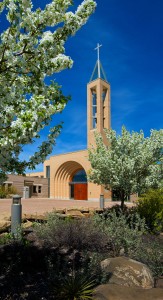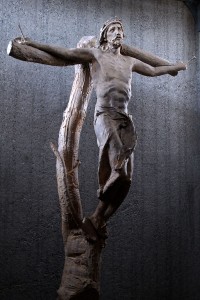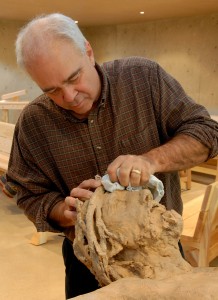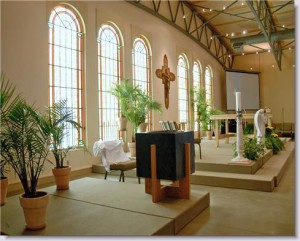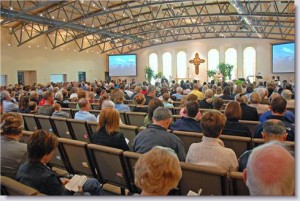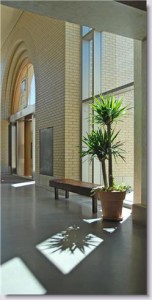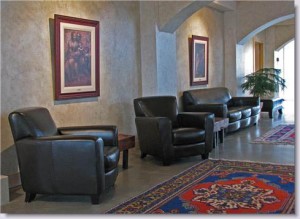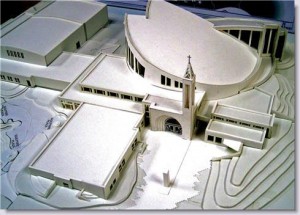“Let’s do something beautiful for God.” These words, attributed to Blessed Mother Teresa of Calcutta, characterize the development philosophy of St. Mary’s Parish Centre in Cochrane, Alberta, dedicated by Calgary Bishop Frederick Henry in 2007.
The parish’s Building Committee worked from the premise that sacred beauty is a window through which we experience more meaningfully the One we worship. In the context of church design, artistic expression is a key component in the pilgrim parishioner’s journey from the secular to the spiritual. As Michael Simpson, past-chair of the Building Committee, explains it, that journey was to be “punctuated by significant works of art to facilitate the transition.”
Thus it is that pilgrims on that journey to St. Mary’s Church are first greeted by a view of the iconic bell tower framed by apple trees that are joyful with the blossoms of spring, vibrant with the leaves of autumn, restful in the hope-filled waiting of winter. To the left, the Sacred Garden provides a quiet place for contemplation and meditation.
Upon entering the welcoming main doors beneath the bell tower, pilgrims face a large seasonal banner on a powerful concrete wall curving left into the Gathering Area. A colonnade of artwork leads to the 600-seat Parish Hall of Phase I, the temporary worship space till the completion, as the population significantly increases, of the formal worship area in Phase II.
Perhaps no finer example of the importance of sacred art for this parish is to be found in the Day Chapel, immediately to the right upon entering the main doors. There, over three metres high, stands The Tree of Life Crucifix by renowned American sculptor John Collier, chief artist for the Catholic Memorial at Ground Zero, New York City.
Its distinctive tree-and-branch cross holds an equally distinctive corpus: a tattered, whipped, and fallen Jesus.
Collier’s inspiration for The Tree of Life Crucifix is found in the biblical accounts of three trees, he says: (1) the tree of life in the Garden of Eden, from which Adam and Eve were alienated by sin; (2) the tree on which Jesus, “the second Adam,” was crucified to counter the human alienation from God brought about by the first Adam; and (3) the tree of life referred to in the conclusion to the Book of Revelation – the tree in the holy city of the new heaven and earth, on either side of the river of life that flows from the throne of God, whose leaves “are for the healing of the nations.”
In these three trees represented in his crucifix, Collier embraces God’s grand story of reconciliation. “The healing journey of salvation is complete,” he says. “Access to the first tree of life has been restored in the new reality of the third tree. God once again is intimately present with His people.”
God Himself became the Artist of history doing something beautiful for humanity – indeed, for all of creation – and invites all future artists to participate in that beauty.
Was it not in that sense that Pope John Paul II famously addressed artists in 1999? Recall his words: “May your art help to affirm that true beauty which, as a glimmer of the Spirit of God, will transfigure matter, opening the human soul to the sense of the eternal.”
That priority certainly underlies John Collier’s commitment to sacred art. “Human beings have always made art about what they think is important,” he says. “I think our Lord is important. I make art about Him.”
That priority also underlies why St. Mary’s Church-Cochrane understands the celebration of sacred beauty to be fundamental to their church development and outreach. Indeed, the pilgrim parishioners, upon their sojourn in this sacred space, are being inspired not only to “do something beautiful for God,” but themselves to become something beautiful for God – God’s artwork in flesh and blood.
More photos of the interior of St. Mary’s Church, Cochrane:
Future Plans:


